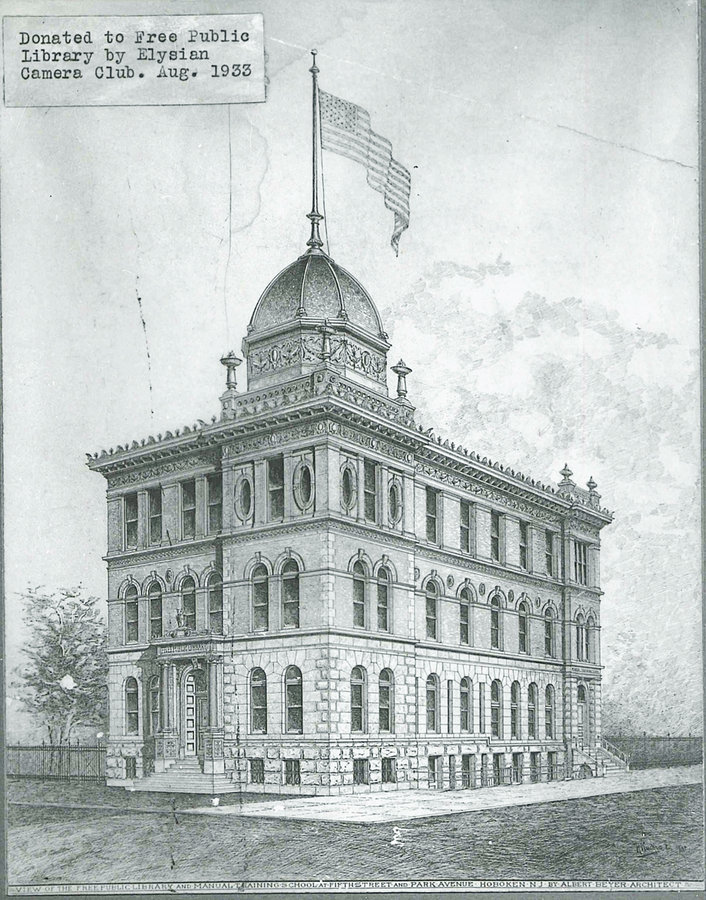The Hoboken Public Library has been serving the needs of bibliophiles and folks who just want to know stuff for 125 years. Or, as habitués of libraries might say, it’s celebrating its quasquicentennial.
The library opened in 1890 on Washington and Second in what was once the National Bank Building. Benefactor Martha Bayard Stevens and her son, of the renowned Hoboken Stevens family, put up the money to build the current library at 500 Park Ave., which was designed by Hoboken architect Alfred Beyer. It opened on April 5, 1897, and is the oldest public library building in New Jersey—not the oldest library but the first dedicated public library building. Stevens, who controlled much of the family fortune, was considered one of the richest women in the United States.
You could probably bottle a fragrance called eau de bibliothèque. I mean, what is it about libraries? All of them seem to have a distinctive aroma. Certainly, books have a scent, the dry old bones of the elderly ones sometimes bringing on sneezing fits. Then there’s the heady essence of humanity learning, loafing, and sometimes living by day in the public library.
Not to mention the smell of polish on all that old Victorian wood. And it does seem as if that era was the golden age of libraries. Here’s an extraordinarily unscientific survey that would make most librarians cringe: The tiny library in my hometown in Massachusetts is housed in a Victorian home, built in 1874, and, at the other end of the spectrum, the New York Public Library broke ground in 1895. Indeed, philanthropist Andrew Carnegie bankrolled 1,689 American libraries between 1883 and 1909. You can look it up.
Martha Stevens, Martha Stewart
What strikes you when you visit the Hoboken Public Library is what Martha Stevens would have thought. Upstairs in the kids’ section, a tiny girl is engrossed in her iPad. The next floor down is the computer room, every work station filled. A sign reads “charging station.”
Amid all the new stuff on these two floors are two gorgeous old nonworking fireplaces with colorful tiles and decorative carvings.
Periodicals are also on this floor. Would Martha be into the yoga magazines? Maybe not, but she might have been intrigued by Ms. Magazine.
Downstairs is a painting of Edwin Augustus Stevens IV and his sister Emily Curtis Lewis Stevens. Here you get a sense of what it might have been like back in the day, but Library Director Lina Podles explains that there was no browsing back then. You chose a card from the catalogue and waited for a librarian to retrieve the book.
Virtual Versus Venerable
To the oft-expressed view that the internet is making libraries obsolete, Podles responds with a resounding no. “It’s a false perception,” she maintains. “The number of people using the collection is growing every year. People are still using and need the library.” She says the library complements the internet’s vast resources. “There’s a rainbow of opportunities; people don’t go to just one source.”
The library supports schools by stocking books on student reading lists, in summer and throughout the school year. Representatives from the library attend open school nights, so that teachers and students are aware of what the library offers. In the works, for example, is an online program to help kids with homework.
“The library is a valuable resource in the community for all ages,” says Podles. “Children who read perform much better. We try to publicize the importance of reading.”
But reading isn’t everything. The library supports a well-rounded education in the increasingly important STEM areas of Science, Technology, Engineering, and Math. It has also launched a very popular maker space and has brought on two more children’s librarians.
The More Things Change…
When the library debuted 125 years ago, it was “very warmly received by the community,” Podles says, “but it was a different library.” It was open long hours. There was a women’s reading room, a law room, and a big collection of German books to accommodate the town’s many German immigrants.
Not only the history of the town but the history of the world is reflected in the library’s 125-year lifetime. For example, it exhibited the books that Hitler hated and burned. “It was such a good celebration of reading and freedom in response to the horrors going on in Germany,” Podles says. “It was a very high moral civil act of the library.”
In the 21st century, the library stepped in during the economic downturn of 2008 to help residents find jobs, offering assistance with resume writing, computer skills, and interviewing techniques. “We stay relevant,” Podles says. “It was really a great reward when someone found a job and came back to say thank you.”
It’s also celebrating Frank Sinatra’s centennial with photos and exhibits.
Ongoing renovations will preserve the integrity of the building, which has been listed on the New Jersey Register of Historic Places.—07030
